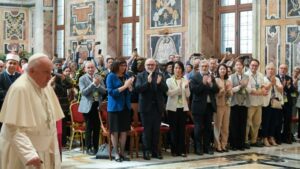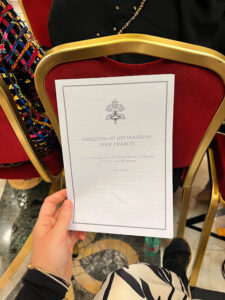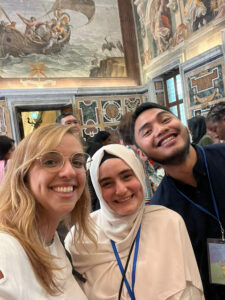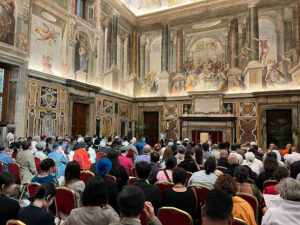 On Monday, the interreligious conference moved to Rome. Better said, it moved to meet Pope Francis. This may sound like a familiar beginning, but it is very realistic. The days of the conference further confirmed my impression, gathered around the world over the years, of the affection and esteem that people of other faiths have for the Argentine pope. Over the last two years, I have collected many such impressions, soon to be published by Città Nuova in a book intriguingly titled Pope Francis Seen from the Outside: What People of Other Faiths Say About the Pope.
On Monday, the interreligious conference moved to Rome. Better said, it moved to meet Pope Francis. This may sound like a familiar beginning, but it is very realistic. The days of the conference further confirmed my impression, gathered around the world over the years, of the affection and esteem that people of other faiths have for the Argentine pope. Over the last two years, I have collected many such impressions, soon to be published by Città Nuova in a book intriguingly titled Pope Francis Seen from the Outside: What People of Other Faiths Say About the Pope.
I was not present at the meeting; I preferred to leave my seat to someone who had never met Pope Francis. From what they told me, the encounter was difficult to describe. I believe it, both because of what I have just said and because of the way the pope engages with people of different cultures and religions. Sometimes it seems that Pope Francis is more at ease in those environments and with those groups than in some parts of the Catholic Church. However, two elements stand out to me.
The first is relationships. Pope Francis greeted everyone warmly and unhurriedly, listening and, as he often emphasizes when discussing dialogue, ‘taking time with each one’. A Hindu professor, whose contribution will appear in my upcoming book, asked me if she could say a few words to the pope. It is always difficult to predict what might happen in audiences, but she was obviously delighted: she spoke to the pope about whom she had written.
The second fundamental element is Pope Francis’ speech. Beyond emphasizing the centrality of dialogue for achieving peace—a discourse he has tirelessly repeated for years—Bergoglio highlighted how Chiara Lubich’s approach had been a true prophecy. Lubich began speaking of dialogue with people of different cultures and faiths at a time when no one else was talking about it—in the Church, among the laity, and especially not among women. It was the disruptive force of a charism that carried a vision of the times and the future—our present times. It was the voice of the Spirit speaking into the heart of the Catholic Church, just as it spoke, at a different level, to the Council Fathers. They would soon publish Nostra Aetate, a revolutionary document, long opposed in the Council Hall and finally published at the end of the Council. However, no one knew what it meant or how it could be implemented. It took charisms like Lubich’s—and others, of course—to show the road map.
On Monday, Pope Francis encountered a cross-section of the fruits of this synergetic conjunction between the hierarchical Church—the Council—and the charismatic Church, represented by Lubich. This Italian woman recognized the same power in other charismatic people outside the Catholic Church: Nikkyo Niwano in Japan, Grand Master Ajhan Tong in Thailand, Imam W.D. Mohammed in the USA, and the Aram couple in India. Out of this and the perseverance of many came this moment, which took half a century to realize. This is why, in my opinion rightly so, Pope Francis said that this experience was “a revolutionary journey that does so much good for the Church. It is an experience animated by the Holy Spirit, rooted—we can say—in the heart of Christ, in his thirst for love, communion, fraternity.”
Moreover, herein lies the crux of the lesson that the Focolare Movement must recognize and embrace, leaving behind fears and inappropriate prudence. A charism cannot be hidden or stifled. Yet, this is what risks happening due to the challenges that afflict those who lose their founder or foundress and face problems common to many in the Catholic Church: abuse, economic emergencies, and the lack of new generational vitality. The future of a charism does not lie, as some observers suggest, in the internal bureaucratization of a movement or ecclesial reality to respond to these emergencies, but in following the charismatic intuition with courage and intelligence—and this also means creativity.
Speaking with some of the young people present during these days, I realized that they grasp this prophecy, but it is necessary to offer it to them and help them decode it. One morning, during a break, I spoke with one of my students who has been working in dialogue for some time. At a certain point, she could no longer speak, and tears started to fall. She is a beautiful, talented girl, successful in the world of communication. Yet, faced with the experience of God with people of other faiths, she was touched to the core. That silence and those tears spoke for themselves. In that moment, prophecy met with her heart and mind. It will be difficult for her to forget this experience. They are indelible.
This, I believe, is what Pope Francis is telling us with his speech and his presence: continue the prophecy of Chiara, do not stifle it.
prophecy of Chiara, do not stifle it.



